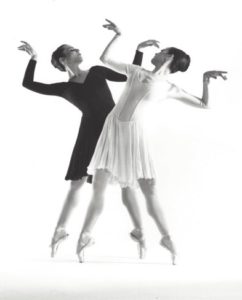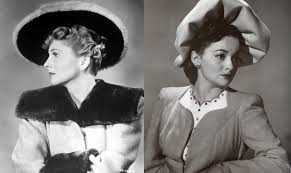The story is as familiar as it is painful to many a dancer. A promotion or a lead role, just within reach, is irrevocably lost, given to another dancer. Someone you admire and respect, someone you might have toiled and danced alongside for years. Now you’re hurting, and all you want to do is go home, grieve, cry, vent, in the security of your home. Only this time it’s more complicated.
This time the other dancer is your sister.
While I myself have five sisters, none shared my passion for ballet while growing up, so as an adult, I decided to explore the situation fictionally. In my 2016 novel, Outside the Limelight, professional dancer Dena, three years her sister Rebecca’s junior, gets the promotion to soloist that Rebecca had been anticipating. The story, if you haven’t yet read it, follows the sisters’ ensuing relationship, through its bumps, challenging circumstances, dramas and traumas, and the ultimate realization that the bond of sisterhood surpasses all others
Real-life ballet sister scenarios play out quite frequently, I’ve since discovered. In a 2013 New York Times article, Patricia and Jeannette Delgado, both principals with Miami City Ballet, discussed their own situation. Much like in my novel, younger sister Jeanette, after years of being the subordinate, excelled extravagantly, prompting dance critic Alastair Macaulay to call her “one of the world’s most marvelous ballerinas.” Patricia, older by two years, was taken aback. In the article, she shares that, “I closed my eyes and opened them, and said, ‘Oh, my God. My sister is amazing,’ I knew she would have opportunities I wouldn’t get, and that was the first time I was dealing with that.” In the long run, however, Patricia credited Jeanette’s success as helping her to elevate her own dancing. “She was blowing me away, and I said, ‘I’ve got to turn it up.’ ” And she went on to do just that. (Read the full article here.)
Ballet sisters Zippora and Romy Karz, who both danced with the New York City Ballet (shown below together, and below that, with their other two siblings) offered their own perspective.
“I am blessed—my sister is my best friend,” said Zippora, the eldest, who rose to soloist rank. “We went through growing-up years, for sure, and I didn’t always turn to her, but she was always there. Romy and I were very different dancers and personalities, and different life happenings, so I don’t think we ever compared ourselves to each other.”
Romy, three years younger, agreed. “I never put myself on her level, and so the competition was not a struggle. I loved being her sister. When I first started at the School of American Ballet, she wouldn’t let me live with her. She wanted me to carve my own place, and for her to have hers, without taking care of me. Within a year, we found great comfort in our relationship with each other, and the desire to live together because we actually wanted to. Being her sister felt like a great honor to me.”
Challenges for ballet sisters can come in other forms. Zippora, who wrote The Sugarless Plum, a memoir chronicling her battle with Type 1 diabetes while dancing, did not share her illness with the other dancers. This increased the sisters’ closeness. “I knew of her incredible struggles with her health,” Romy said. “I knew how hard it was, so I worried a lot about her. That was stressful for me. It was hard to separate from my connection and caring of her, within company life.”
Lauren Jonas, artistic director of Walnut Creek-based Diablo Ballet, had not one but two ballet sisters, growing up. From the family’s home base in San Rafael, the three of them trained at the Marin Ballet. Mindy was five years older than Lauren, Corinne two years younger. All three went on to dance professionally, although Mindy was forced to retire at a very young age due to a bad foot injury that never healed properly. Lauren joined the Milwaukee Ballet after completing training, and Corinne joined the Houston Ballet.
Here, then, is another challenge ballet dancer sisters face: the prospect of being geographically separated. Cuban sisters and principal dancers Lorena and Lorna Feijóo spent their professional careers in San Francisco and Boston respectively. Sisters Maria Sascha and Nadia Khan, Montana natives, are based in Russia and Rome (and have two brothers, also professional ballet dancers, based in London and St. Petersburg). The Jonas sisters dispersed to New York, Milwaukee and Houston.
“It’s hard being in different companies,” Lauren admitted. “Living far apart, not being able to seeing the other dance, after those years of training together. You’re used to having that support right there, and then it’s gone.”
Years later, in an intriguing twist, Lauren co-founded Diablo Ballet, and a few years later Corinne joined the company, the two younger sisters finally dancing together on the same professional stage. This did, however, bring new sister-related challenges: Lauren had to refrain from showing any administrative favoritism toward this new dancer who was also her sister.

I asked Lauren what helped the two of them overcome any sense of competition in their youth. “It helped that we were very different dancers,” she replied. “I was very Don Q, good at fouettés, jumps, pirouettes. Corinne was more Juliet, lyrical and flowing. Although, we looked alike and choreographers liked playing around with that.” In choreographer Sally Streets’ 1997 ballet, Encores, Lauren danced in front of a mirror, where she encountered her mirrored self: her dancing sister.
I asked these ballet professionals what kind of advice regarding sibling rivalry they might offer today’s aspiring ballet dancer sisters. All were in agreement: figure out what you yourself are good at, what makes you unique, and work to improve and refine that.
“We all have to carve out who we are,” Romy said. “It’s a natural thing to feel jealous of someone who has what you want, and that may be better arches, extensions and parts in a ballet, and that may be your best friend, your worst enemy or your sibling. I think it’s healthy to feel what you’re feeling, and then to examine what you can do about it. Harboring those feelings won’t bring you closer to your own goals, but focusing on your own work and keeping your focus on your own goals will.”

Here are but a few names of professional ballet dancer sisters through the past generation. Can you add to the list?
Maria and Marjorie Tallchief
Patricia and Coleen Neary
Johnna and Gelsey Kirkland
Tina and Sheri LeBlanc
Kathleen and Margaret Tracey
Laura and Elise Flagg
Svetlana and Yulia Lunkina
Leigh-Ann and Sara Esty
Mary Mills Thomas and Melissa Thomas
Zenaida and Nadia Yanowsky
This article first appeared at Dance Advantage with The Classical Girl’s permission.
© 2017 Terez Rose


Terez – great read. You may not be aware that I begged mom and dad to let me take dance instead of piano lessons. To this day, whenever I watch talented ballet and other dancers I feel restive, like I want to get up and dance with them.
No WAY, Annette! Well, your talents are many, then, because I remember how phenomenal you were on the piano AND the way you moved so brilliantly when you were on drill team for Shawnee Mission East. (Bittersweet humor: remember how I kept trying out for Bishop Miege drill team and failed 3x to get in? And how devastated I was? And yet, I would have likely dropped ballet, had “the dream” happened. Funny how what feels unbearably disappointing and painful at the time can serve to shape you for the thing you were REALLY meant to do.)
Gelsey is multitudes more a ballerina.
History would certainly concur with your pronouncement, ML! I didn’t even know Gelsey had a dance sister, until I saw, in 2010, an archived photo of the two of them from years back. It was a thought-provoking photo (and ultimately resulted in my building the second Ballet Theatre Chronicles novel). It can’t have been easy to be Gelsey Kirkland’s “less accomplished” ballet sister.